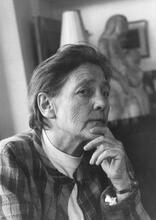Margaret Mahler
Margaret Schönberger Mahler pioneered theories on child development and abnormal psychology that impacted generations of psychiatrists. Mahler began studying medicine in Budapest in 1917 and earned her doctorate from the University of Jena in 1922. She then opened a pediatric practice in Vienna and began training at the Vienna Psychoanalytic Society. She fled the Anschluss in 1938 for the United States. She simultaneously taught psychiatry at Columbia University and directed the child analysis training program of the Philadelphia Psychoanalytic Institute, shuttling between New York and Philadelphia. In 1962 created the Masters Child Center for studying interaction between mothers and their children under age three. She wrote extensively on the mother-child relationship and the separation-individuation process, and in her therapies she encouraged mothers to become partners in their children’s treatment, a pioneering approach.
Article
Margaret Schönberger Mahler, a pioneering child analyst, began her career in Vienna but made her most important discoveries in the United States. She became a leading authority on the mother-child relationship and the separation-individuation process, which she examined in her best-known work, The Psychological Birth of the Human Infant.
Born on May 10, 1897, in Sopron, Hungary, she spoke German to her mother, Eugenia (Wiener) Schönberger, and Hungarian to her father, Gusztav Schönberger (originally Fertoszentmiklos). Resentful of her beautiful younger sister, who resembled their mother, Margaret decided to follow in her adored father’s footsteps by becoming a physician. At sixteen, she left Sopron for Budapest, where she began her medical studies in 1917. After encountering antisemitism and discrimination as a foreign student in Munich, Jena, and Heidelberg after World War I, she received her doctorate from the University of Jena in 1922 and then moved to Vienna, where she obtained her medical license and established a private pediatric practice.
Introduced to psychoanalytic theories by Sandor Ferenczi in Budapest, she became affiliated with the Vienna Psychoanalytic Society and underwent training analysis, first with Helene Deutsch and later with August Aichhorn and Willi Hoffer. Having worked as an assistant in two pediatric clinics, she became a municipal youth and welfare physician and conducted research on juvenile delinquents in Aichhorn’s child guidance centers. In 1938, after the Anschluss, she left Vienna for England together with her husband, Paul Mahler, a Jewish chemist whom she had married two years previously. After a brief stay in London, they immigrated to the United States.
Settling in New York, Mahler passed her state medical boards in 1939 and became a member of the New York Psychoanalytic Society. In the 1940s, she worked as an unsalaried consultant at the New York State Psychiatric Institute and Mount Sinai Hospital and taught psychiatry at Columbia University before joining the faculty of the Albert Einstein College of Medicine in 1950. Commuting from New York to Philadelphia on weekends, she directed the child analysis training program of the Philadelphia Psychoanalytic Institute. In 1956, she established a therapeutic nursery program for psychotic children at Einstein. In 1962, with a grant from the National Institute of Mental Health, she created the Masters Child Center, a laboratory for the study of the interaction between mothers and their children under three.
Margaret Mahler was not an observant Jew; her Jewish identity was shaped by the antisemitism she experienced in her youth and her mother’s death during the Holocaust. Her last wish before her death on October 2, 1985, was that her ashes, together with those of her husband, be interred in the Jewish cemetery in Sopron, alongside her father’s grave.
For almost forty years, Margaret S. Mahler was actively involved in teaching, clinical practice, and research in the United States. She published several books and over a hundred scholarly papers. Among the sizable group of emigrés from Nazi Europe who helped shape American psychoanalysis, she stands out as one of the most highly respected and honored for her major contributions to the development of child psychology.
Selected Works
The Memoirs of Margaret S. Mahler. Edited by Paul E. Stepansky (1988).
On Human Symbiosis and Vicissitudes of Individuation (1968).
The Psychological Birth of the Human Infant: Symbiosis and Individuation, with F. Pine and A. Bergman (1975).
The Selected Papers of Margaret S. Mahler. Vol. I: Infantile Psychosis and Early Contribution. Vol. II: Separation—Individuation (1979).
Dick, Jutta, and Marina Sassenberg, eds. Jüdische Frauen im 19. und 20. Jahrhundert: Lexikon zu Leben und Werk (1993).
Dickstein, Leah J., and Carol C. Nadelson. Women Physicians in Leadership Roles (1986).
EJ.
International Biographical Dictionary of Central European Emigrés. Vol. 2, part 2 (1980): 763.
International Encyclopedia of Psychiatry, Psychology, Psychoanalysis and Neurology. Vol. 6. Edited by B.B. Wolman (1972).
McDevitt, John B., and Calvin F. Settlage, eds. Separation—Individuation: Essays in Honor of Margaret S. Mahler (1971).
Mahler, Margaret. Papers. Margaret Mahler Collection. A.A. Brill Library, New York Psychoanalytic Society and Institute, New York.
Mühlleitner, Elke, ed. Biographisches Lexikon der Psychoanalyse: Die Mitglieder der Psychoanalytischen Vereinigung 1902–1938 (1992).
Obituaries. NYTimes, October 3, 1985, and Züricher Tages-Anzeiger, October 15, 1985.
Peters, Uwe Henrik. Psychiatrie im Exil (1992).
Stevens, Gwendolyn, and Sheldon Gardner. The Women of Psychology 2 (1982): 52–55.
Swerdloff, Bluma. Interviews with Margaret Mahler, 1969–1974. Oral History Research Project, Butler Library, Columbia University, NYC.



